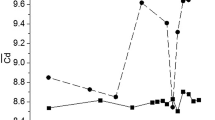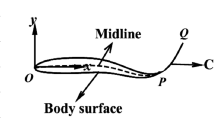Abstract
This paper numerically investigates the self-propelled swimming of a flexible filament driven by coupled pitching and plunging motions at the leading edge. The influences of bending rigidity and some actuation parameters (including the phase offset between pitching and plunging, and the amplitudes of pitching and plunging motions) on the swimming performance are explored. It is found that with increasing rigidity, the swimming style gradually transits from the undulatory mode to the oscillatory mode. The plunging-pitching actuation is found to be superior to the plunging-only actuation, in the sense that it prevents the decrease of speed at high rigidity and achieves a higher efficiency across a wide range of rigidity. The comparison of the body kinematics with those of animal swimmers, and the classification of the wake structures are discussed. The results of this study provide some novel insights for the bio-inspired design of autonomous underwater vehicles.
Similar content being viewed by others
References
Lauder G. V., Anderson E. J., Tangorra J. et al. Fish biorobotics: Kinematics and hydrodynamics of self-propulsion [J]. Journal of Experimental Biology, 2007, 210(16): 2767–2780.
Wang S. Z., He G. W., Zhang X. Self-propulsion of flapping bodies in viscous fluids: Recent advances and perspectives [J]. Acta Mechanica Sinica, 2016, 32(6): 980–990.
Liu C., Hu C. An efficient immersed boundary treatment for complex moving object [J]. Journal of Computational Physics, 2014, 274: 654–680.
Gronskis A., Artana G. A simple and efficient direct forcing immersed boundary method combined with a high order compact scheme for simulating flows with moving rigid boundaries [J]. Computers and Fluids, 2016, 124: 86–104.
Hua R. N., Zhu L., Lu X. Y. Locomotion of a flapping flexible plate [J]. Physics of Fluids, 2013, 25(12): 121901.
Zhu X., He G., Zhang X. Numerical study on hydrodynamic effect of flexibility in a self-propelled plunging foil [J]. Computers and Fluids, 2014, 97: 1–20.
Olivier M., Dumas G. Effects of mass and chordwise flexibility on 2D self-propelled flapping wings [J]. Journal of Fluids and Structures, 2016, 64: 46–66.
Zhang D., Pan G., Chao L. et al. Effects of Reynolds number and thickness on an undulatory self-propelled foil [J]. Physics of Fluids, 2018, 30(7): 071902.
Hoover A. P., Cortez R., Tytell E. D. et al. Swimming performance, resonance and shape evolution in heaving flexible panels [J]. Journal of Fluid Mechanics, 2018, 847: 386–416.
Ryu J., Park S. G., Huang W. X. et al. Hydrodynamics of a three-dimensional self-propelled flexible plate [J]. Physics of Fluids, 2019, 31(2): 021902.
Zhu X., He G., Zhang X. How flexibility affects the wake symmetry properties of a self-propelled plunging foil [J]. Journal of Fluid Mechanics, 2014, 751: 164–183.
Lauder G. V., Madden P. G. A., Tangorra J. L. Bioinspiration from fish for smart material design and function [J]. Smart Materials and Structures, 2011, 20(9): 094014.
Lauder G. V., Lim J., Shelton R. et al. Robotic models for studying undulatory locomotion in fishes [J]. Marine Technology Society Journal, 2011, 45(4): 41–55.
Lauder G. V., Flammang B., Alben S. Passive robotic models of propulsion by the bodies and caudal fins of fish [J]. Integrative and Comparative Biology, 2012, 52(5): 576–587.
Shelton R. M., Thornycroft P. J. M., Lauder G. V. Undulatory locomotion of flexible foils as biomimetic models for understanding fish propulsion [J]. Journal of Experimental Biology, 2014, 217(12): 2110–2120.
Feilich K. L., Lauder G. V. Passive mechanical models of fish caudal fins: Effects of shape and stiffness on self-propulsion [J]. Bioinspiration and Biomimetics, 2015, 10(3): 036002.
Lucas K. N., Thornycroft P. J. M., Gemmell B. J. et al. Effects of non-uniform stiffness on the swimming performance of a passively-flexing, fish-like foil model [J]. Bioinspiration and Biomimetics, 2015, 10(5): 056019.
Ramananarivo S., Godoy-Diana R., Thiria B. Passive elastic mechanism to mimic fish-muscle action in anguilliform swimming [J]. Journal of the Royal Society Interface, 2013, 10 (88): 20130667.
Dai L., He G., Zhang X. et al. Stable formations of self-propelled fish-like swimmers induced by hydrodynamic interactions [J]. Journal of Royal Society Interface, 2018, 15(147): 20180490.
Dai L., He G., Zhang X. et al. Intermittent loco-motion of a fish-like swimmer driven by passive elastic mechanism [J]. Bioinspiration and Biomimetics, 2018, 13(5): 056011.
Kim B., Park S. G., Huang W. et al. Self-propelled heaving and pitching flexible fin in a quiescent flow [J]. International Journal of Heat and Fluid Flow, 2016, 62: 273–281.
Piñeirua M., Thiria B., Godoy-Diana R. Modelling of an actuated elastic swimmer [J]. Journal of Fluid Mechanics, 2017, 829: 731–750.
Huang W. X., Shin S. J., Sung H. J. Simulation of flexible filaments in a uniform flow by the immersed boundary method [J]. Journal of Computational Physics, 2007, 226(2): 2206–2228.
Wang S. Z., Zhang X. An immersed boundary method based on discrete stream function formulation for two- and three-dimensional incompressible flows [J]. Journal of Computational Physics, 2011, 230(9): 3479–3499.
Wang S., He G., Zhang X. Parallel computing strategy for a flow solver based on immersed boundary method and discrete stream-function formulation [J]. Computers and Fluids, 2013, 88: 210–224.
Dai L., He G., Zhang X. Self-propelled swimming of a flexible plunging foil near a solid wall [J]. Bioinsipration and Biomimetics, 2016, 11(4): 046005.
Yang X., Zhang X., Li Z. et al. A smoothing technique for discrete delta functions with application to immersed boundary method in moving boundary simulations [J]. Journal of Computational Physics, 228(20): 7821–7836.
Kern S., Koumoutsakos P. Simulations of optimized anguilliform swimming [J]. Journal of Experimental Biology, 2006, 209(24): 4841–4857.
Videler J. J. Fish swimming [M]. Berlin, Germany: Springer, 1993.
Piñeirua M., Thiria B., Godoy-Diana R. Resistive thrust production can be as crucial as added mass mechanisms for inertial undulatory swimmers [J]. Physical Review E, 2015, 92(2): 021001.
Cui Z., Yang Z. X., Shen L. et al. Complex modal analysis of the movements of swimming fish propelled by body and/or caudal fin [J]. Wave Motion, 2018, 78: 83–97.
Taylor G. K., Nudds R. L., Thomas A. L. R. Flying and swimming animals cruise at a Strouhal number tuned for high power efficiency [J]. Nature, 2003, 425(6959): 707–711.
Triantafyllou M., Triantafyllou G., Gopalkrishnan R. Wake mechanics for thrust generation in oscillating foils [J]. Physics of Fluids A: Fluid Dynamics, 1991, 3(12): 2835–2837.
Borazjani I., Sotiropoulos F. Numerical investigation of the hydrodynamics of carangiform swimming in the transitional and inertial flow regimes [J]. Journal of Experimental Biology, 2008, 211(10): 1541–1558.
Borazjani I., Sotiropoulos F. Numerical investigation of the hydrodynamics of anguilliform swimming in the transitional and inertial flow regimes [J]. Journal of Experimental Biology, 2009, 212(4): 576–592.
Nangia N., Bale R., Chen N. et al. Optimal specific wavelength for maximum thrust production in undulatory propulsion [J]. PLoS One, 2017, 12(6): e0179727.
Reid D. A. P., Hildenbrandt H., Padding J. T. et al. Fluid dynamics of moving fish in a two-dimensional multiparticle collision dynamics model [J]. Physical Review E, 2012, 85(2): 021901.
Weerden J. F., Reid D. A. P., Hemelrijk C. K. A meta-analysis of steady undulatory swimming [J]. Fish and Fisheries, 2014, 15(3): 397–409.
Lin X., Wu J., Zhang T. Performance investigation of a self-propelled foil with combined oscillating motion in stationary fluid [J]. Ocean Engineering, 2019, 175: 33–49.
Quinn D. B., Lauder G. V., Smits A. J. Maximizing the efficiency of a flexible propulsor using experimental optimization [J]. Journal of Fluid Mechanics, 2015, 767: 430–448.
Isogai K., Shinmoto Y., Watanabe Y. Effects of dynamic stall on propulsive efficiency and thrust of flapping airfoil [J]. AIAA Journal, 1993, 37(10): 1145–1151.
Ramamurti R., Sandberg W. Simulation of flow about flapping airfoils using finite element incompressible flow solver [J]. AIAA Journal, 2001, 39(2): 253–260.
Guglielmini L., Blondeaux P. Propulsive efficiency of oscillating foils [J]. European Journal of Mechanics, B/Fluids, 2004, 23(2): 255–278.
Schnipper T., Andersen A., Bohr T. Vortex wakes of a flapping foil [J]. Journal of Fluid Mechanics, 2009, 633: 411–423.
Marais C., Thiria B., Wesfreid J. E. et al. Stabilizing effect of flexibility in the wake of a flapping foil [J]. Journal of Fluid Mechanics, 2012, 710: 659–669.
Acknowledgements
This work was supported by the Chinese Academy of Sciences (Grant Nos. XDB22040104, XDA22040203). We would like to thank Dr. Long-zhen Dai for the development of the FSI code, and the National Supercomputing Center in Tianjin (NSCC-TJ) for the allocation of computing time.
Author information
Authors and Affiliations
Corresponding author
Additional information
Project supported by the National Natural Science Foundation of China (Grant Nos. 11772338, 11372331).
Biography
Bing-lin Li (1993-), Male, Master, E-mail: binglinli106@126.com
Rights and permissions
About this article
Cite this article
Li, Bl., Wang, Yw., Yin, B. et al. Self-propelled swimming of a flexible filament driven by coupled plunging and pitching motions. J Hydrodyn 33, 157–169 (2021). https://doi.org/10.1007/s42241-021-0018-8
Received:
Revised:
Accepted:
Published:
Issue Date:
DOI: https://doi.org/10.1007/s42241-021-0018-8




